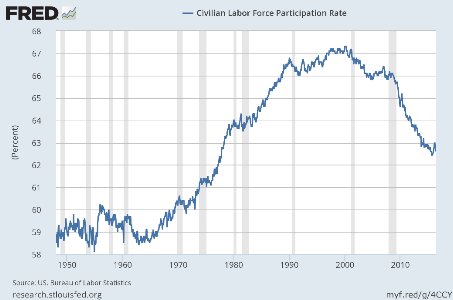Labor force participation has been steadily decreasing from its early 2000’s peak. This is likely due to several factors, with varying levels of attribution.
Automation has been slowly become the adopted norm for everything from marketing, to product creation. Per an earlier civilian-labor-forceanalysis done by “Marketo & Ascend” on average 49% of companies are currently using Marketing Automation of one form or another, which in turn on average drove an increase of 14.5% in sales according to Nucleus Research.
Outsourcing to Foreign Countries has increased significantly, with 2015 statistics reporting nearly 2,500,000 outsourced jobs with 38% of CFO’s reporting their firm was currently offshore outsourcing. This being an increase from the approximately 2,100,000 outsourced jobs in 2014; with the majority of these jobs going to India and China.
Job loss due to commodity based price trends(e.g. oil) are having a major negative pull with a total job loss of over 100,000 in the Oil/Gas production industry alone in 2015; with many expectations that this job slump will only increase due to the continued low prices. (<$50) as of 2016.
Regardless of this ever decreasing labor force participation rate due to the above listed factors, the average number of worked hours has stayed relatively flagged suggesting that regardless of productivity gains through automation, and automation though resulting in less overall labor, has not resulted in less hours worked for the current laborers.
moving-averageThis graph demonstrates the decrease in the awards, and applications for SS disability, an interesting change with this disability application peaking during the recent recession of 2008, and since decreasing yearly. The actual percentage of disabled persons at any time though has remained a consistent near 11% of the total labor-population, or approximately 24 million persons; this also contributing to long-term lack of labor participation, and also compounded with the fact new laborers are consistently entering the market.
Overall with the above listed factors, and displayed trends of participation rates, and disability, it can be assumed that the labor force participation rate will continue to decrease consistently year over year, especially with ever rising levels of automation, outsourcing, and negative commodity based price trends.




 June 15, 2016
June 15, 2016 By admin
By admin